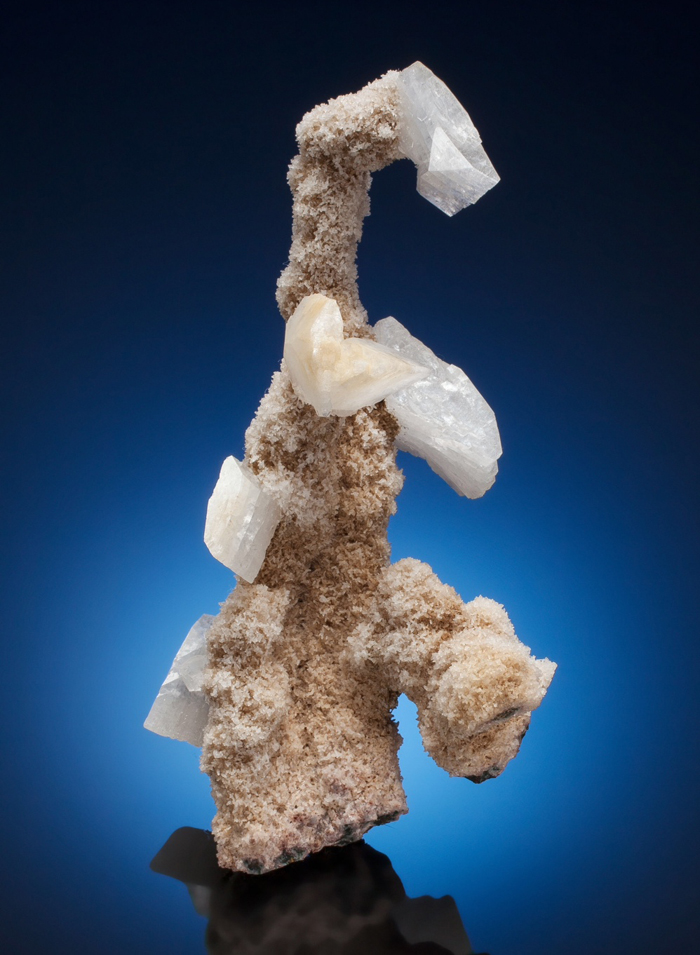'Godzilla' the Hockey Goalie? Rare Mineral Specimen Up for Sale

The minerals are common, but the configuration of this 6-inch-tall specimen makes it one-of-a-kind. The unusual form, which came together in a bubble in a lava flow, inspired the nickname Godzilla as a Hockey Goalie. This piece is among the mineral specimens for sale at a public auction scheduled for May 4.
Tiny crystals of calcite give Godzilla's "body" a fuzzy appearance, while much larger, sharp white crystals of the mineral heulandite stand in for head and arms. These minerals crystallized onto a stalactitemade of chalcedony (cal-said-nee).
Godzilla comes from the Deccan Traps, an ancient, massive lava formation in India, produced by eruptions about 65 million years ago. Bubbles in the lava allowed for the formation of "lava-cicles" or stalactites that dripped down from the ceiling of the bubble, sometimes creating antler, tree or, in this case, sporty monsterlike forms.
"When these things grow, they tend to be like nature pulling a slot machine handle," said Jim Walker,a director of the nature and sciencedepartment at the auction house Heritage Auctions, which is offering this specimen for sale. "This one we like because it has a neat aesthetic arrangement." [See Photos of the Godzilla Mineral & Other Auction Specimens]
Sometimes, these mineral forms span the bubble, so when taken out they have two broken ends, a feature that makes them less desirable to collectors. The Godzilla specimen is broken only at one end, where it was removed from the wall of the bubble, and it has sharp, lustrous crystals — a particularly desirable feature that adds to the perceived value, Walker said.
As lava rises toward the Earth's surface, compressed gases inside can expand to form bubbles. If the temperature and pressure are right, other liquids or gases in the lava will begin to precipitate out into the bubble. This happened first for the chalcedony mineral (in the Godzilla specimen), which formed a stalagmite. Then, the calcite precipitated out, forming many tiny crystals, and, finally as cooling continued, the heulandite precipitated, forming large crystals.
The result was a crystal-covered structure that suggests a figure with a long dinosaurlike neck, arms swinging and one leg striding forward.
Get the world’s most fascinating discoveries delivered straight to your inbox.
"'His' lower portions look like the kind of padded leg armor that hockey goalies tend to wear to deflect supersonic pucks," Walker, who nicknamed the specimen, told Live Science.
The rarity of a mineral is only one of many considerations among collectors. The quality of the crystals, the condition of the specimen, its aesthetic appeal, prior ownership by a famous person, scientific value and so on also factor in.
Considerations like these can increase the value of specimens, such as Godzilla, that contain otherwise common minerals. In another example, unusually transparent, orange-hued crystals contributed to the $20,000-plus estimated value of a chunk of the otherwise common zinc ore sphalerite for sale in the upcoming auction.
With an estimated value of between $250 and $350, Godzilla falls toward the more affordable end, among specimens with estimated values that can range into tens of thousands of dollars, and occasionally beyond.
Bids can be placed in advance or at the May 4 auction in Dallas, Texas.
Follow us @livescience, Facebook & Google+. Original article on Live Science.



